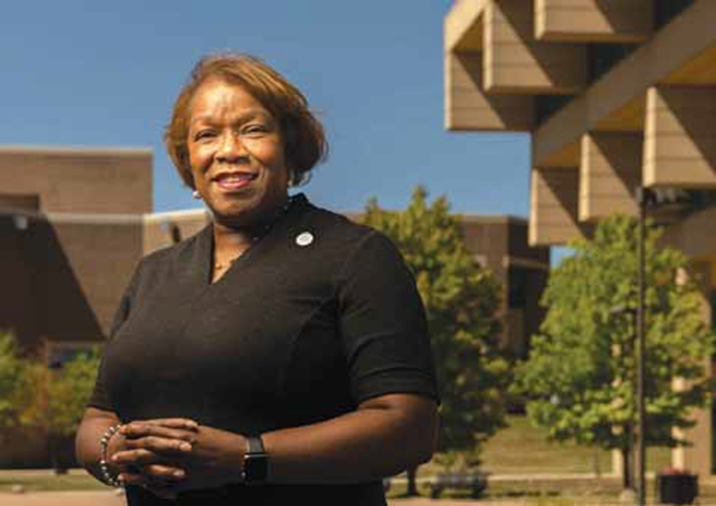Adding dorms will fuel CSU’s enrollment growth, prez says
By Judith Crown

Chicago State University President Zaldwaynaka “Z” Scott is worried about a statewide decline in college attendance, but especially the drop in Black student enrollment.
Enrollment in bachelor degree programs by African American students fell 21% between 2012 and 2022, according to the Illinois Board of Higher Education, out- pacing the overall decline in undergraduate enrollment of 14.4% in the same period.
That’s in large part why Scott is undertaking an ambitious plan to build more housing and amenities, thereby making CSU more at- tractive to candidates looking to live on campus at the predominantly Black institution. The student population is 76% African American and 9% Hispanic.
“Many students would like to have a full experience by staying on campus, and we want to make sure that they have that experience,” she says. The college added beds for nearly 100 additional students, bringing its housing capacity to 350, but 80 students still remain on a waitlist.
Plans published during the summer call for building a dorm that accommodates 528 students, along with 25,000 square feet of retail space. Scott says restaurant and entertainment options are likely, “but we’re going to leave that to the professionals to understand what the neighborhood is looking for.” CSU has invited proposals to be submitted this month, and a development team is to be selected in early December.
The university has a rich history, having been founded after the Civil War in a leaky railroad box-car. Over 150 years, this school evolved from Chicago Normal School to Chicago Teachers College, and eventually to CSU. It was known for training teachers, nurses and specialists in public administration. However, undergraduate enrollment has declined in recent years, falling by two- thirds to more than 2,460 this year from more than 7,100 students in 2005, according to the Illinois Board of Higher Education.
Scott is striving to boost enrollment by 10% a year over the next five years.
The declines are due in part to rising tuition and alternative job opportunities. The pandemic didn’t help. “COVID was a turning point for minority communities,” Scott says.
“It was sad to see that deterioration, but President Scott has come in with a renewed sense of purpose,” says Abraham Lacy, executive director of the Far South Community Development Corp. Scott has served as the school’s president since 2018.
Construction of a new Metra station at 95th Street and Cottage Grove Avenue should open up CSU as a commuter option for students from the south suburbs. Previously, 95th Street was merely a “flag stop,” meaning passengers literally had to wave or flag the train engineer. It wasn’t an automatic stop.
“Going up to the train, you didn’t know if you were going to come out dead or alive,” says Andrea Reed, executive director of the Greater Roseland Chamber of Commerce and a co-founder of the Coalition for a Modern Metra Electric.
Because of the complexity of financing, the CSU project will likely draw mission-driven developers such as Chicago Neighborhood Initiatives, or CNI, which is teaming with Far South Community Development Corp. and the Hope Center Foundation to submit a proposal.
CSU has the potential to boost the surrounding neighborhood and serve as a hub, just as the University of Illinois Chicago rejuvenated Roosevelt Road, says Lacy of the Far South CDC. “Can 95th Street win a little of that?” he asks. CNI President David Doig estimates the project could cost about $30 million, including approximately $7.5 million for the retail space. In addition to a capital contribution from the state, a dorm is likely to require an operating subsidy. Room and board ranges from $10,000 to $20,000 at public universities.
“They’re going to need resident advisers, cleaning staff, utilities and all the stuff that goes into a dorm,” Doig says. “So there's going to have to be some operating support to be able to make these numbers work.” If they land the project, Doig and his partners expect to team with a developer who specializes in student housing.
Housing will be key to CSU’s future as the school loses students to competing institutions that offer the opportunity to stay on campus. “I think we will expand enrollment as many students consider Chicago State the destination of choice,” Scott says.

 All Rights Reserved
All Rights Reserved